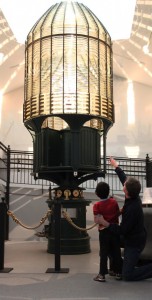Welcome to the Westport Maritime Museum & Grays Harbor Light House

The Westport Maritime Museum located in the historic Coast Guard station building, built in 1939. The original building was designed to traditional Nantucket-Coast Guard Architecture Standards and sits within a five-building complex in the Marina District of Westport.
The original structures are registered as historic buildings with the State of Washington. The Westport-South Beach Historical Society, a non-profit organization dedicated to preserving and interpreting the history of the South Beach, operates the museum
The magnificent Destruction Island Lens, housed on the museum grounds, was built in France in 1888 by Henry Le Paute from the design by Augustin-Jean Fresnel. It was shipped by boat to Destruction Island, north of Westport, on the Washington coast. The lens was installed in the lighthouse in 1891 and operated until 1995 when it was removed by the Coast Guard and went on display at its present location.
The museum showcases exhibits on the maritime history of the South Beach. Current historical exhibits include the Grays Harbor Light Station, the Coast Guard, area shipwrecks, rescue operations, and the whaling and fishing industries. Cranberry harvesting and logging tools are also on display.
Natural history exhibits include beach erosion, currents, beach combing, ocean, and marine mammals, two outdoor exhibits on the grounds feature skeletons of sea mammals, a scale-model of the former Coast Guard station, and a knot-tying display.
Before modern strobe lights, lenses were used to concentrate the light from a continuous source. Vertical light rays of the lamp are redirected into a horizontal plane, and horizontally the light is focused into one or a few directions at a time, with the light beamswept around. As a result, in addition to seeing the side of the light beam, the light is directly visible from greater distances, and with an identifying light characteristic.
This concentration of light is accomplished with a rotating lens assembly. In early lighthouses, the light source was a kerosene lamp or, earlier, an animal or vegetable oil Argand lamp, and the lenses rotated by a weight driven clockwork assembly wound bylighthouse keepers, sometimes as often as every two hours. The lens assembly sometimes floated in liquid mercury to reduce friction. In more modern lighthouses, electric lights and motor drives were used, generally powered by diesel electric generators. These also supplied electricity for the lighthouse keepers.[18]
Efficiently concentrating the light from a large omnidirectional light source requires a very large diameter lens. This would require a very thick and heavy lens if a conventional lens were used. The Fresnel lens (pronounced /freɪˈnɛl/) focused 85% of a lamp's light versus the 20% focused with the parabolic reflectors of the time. Its design enabled construction of lenses of large size and short focal length without the weight and volume of material in conventional lens designs.[21]
Fresnel lenses are ranked by order, a measure of refracting power, with a first order lens being the largest, most powerful and expensive; and a sixth order lens being the smallest. The order is based on the focal length of the lens. A first order lens has the longest focal length, with the sixth being the shortest. Coastal lighthouses generally use first, second, or third order lenses, while harbor lights and beacons use fourth, fifth, or sixth order lenses.[22]
Some lighthouses, such as those at Cape Race, Newfoundland, and Makapuu Point, Hawaii, used a more powerfulhyperradiant Fresnel lens manufactured by the firm of Chance Brothers.
In recent times, many Fresnel lenses have been replaced by rotating aerobeacons which require less maintenance. In modern automated lighthouses, this system of rotating lenses is often replaced by a high intensity light that emits brief omnidirectional flashes (concentrating the light in time rather than direction). These lights are similar to obstruction lights used to warn aircraft of tall structures. Recent innovations are "Vega Lights", and initial experiments with light-emitting diode(LED) panels.[18]
Have YOU climbed Washington’s Tallest Lighthouse Yet?
At 107 feet tall, the Grays Harbor Lighthouse is the tallest lighthouse in Washington State. Considered by its architect, Carl Leick, to be his masterpiece, the Grays Harbor Lighthouse is the pride of Westport, Washington, and Grays Harbor County.
Construction of the lighthouse began in 1897. On June 30, 1898, a dedication ceremony was held at the base of the lighthouse and that night marked the first official service of the Grays Harbor Light.
Originally located approximately 300 feet from the water’s edge, the lighthouse now sits about 3,000 feet from the high tide mark. This change occurred from land accretion in the area, due in part, by construction of the jetty system in the early 1900s.
The walls at the base of this octagonal structure are four feet thick, tapering up to an 18 inch width. They are made up internally of red brick and coated with concrete on the inside and outside. A metal structure completes the top of the tower.
There are 135 steps leading up to the lantern room. The staircase is original and forged of cast-iron. The manufacturer of the metalwork was Patrick Dundon of San Francisco Boiler Works. The landing brackets are pieces of artwork themselves. They are mounted to the wall to support the landings; the staircase is self supporting.
Unlike many lighthouses, the Grays Harbor Light still houses the original 3rd order clamshell-shaped Fresnel lens. This lens was built in Paris, France in 1895 and visitors can climb to the lens (or lantern) room level. The flash pattern of this lens was, and still is, red and white to mark the opening to Grays Harbor. As the lighthouse itself is still an aid to navigation, visitors are able to see the current beacon mounted to the outside railing.
With a 360° view of the ocean and surrounding areas, it is a photographer’s dream. Come on a clear day and you might even be able to see the top of Mount Rainier to the east.











No comments:
Post a Comment